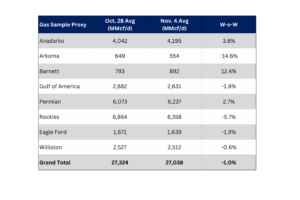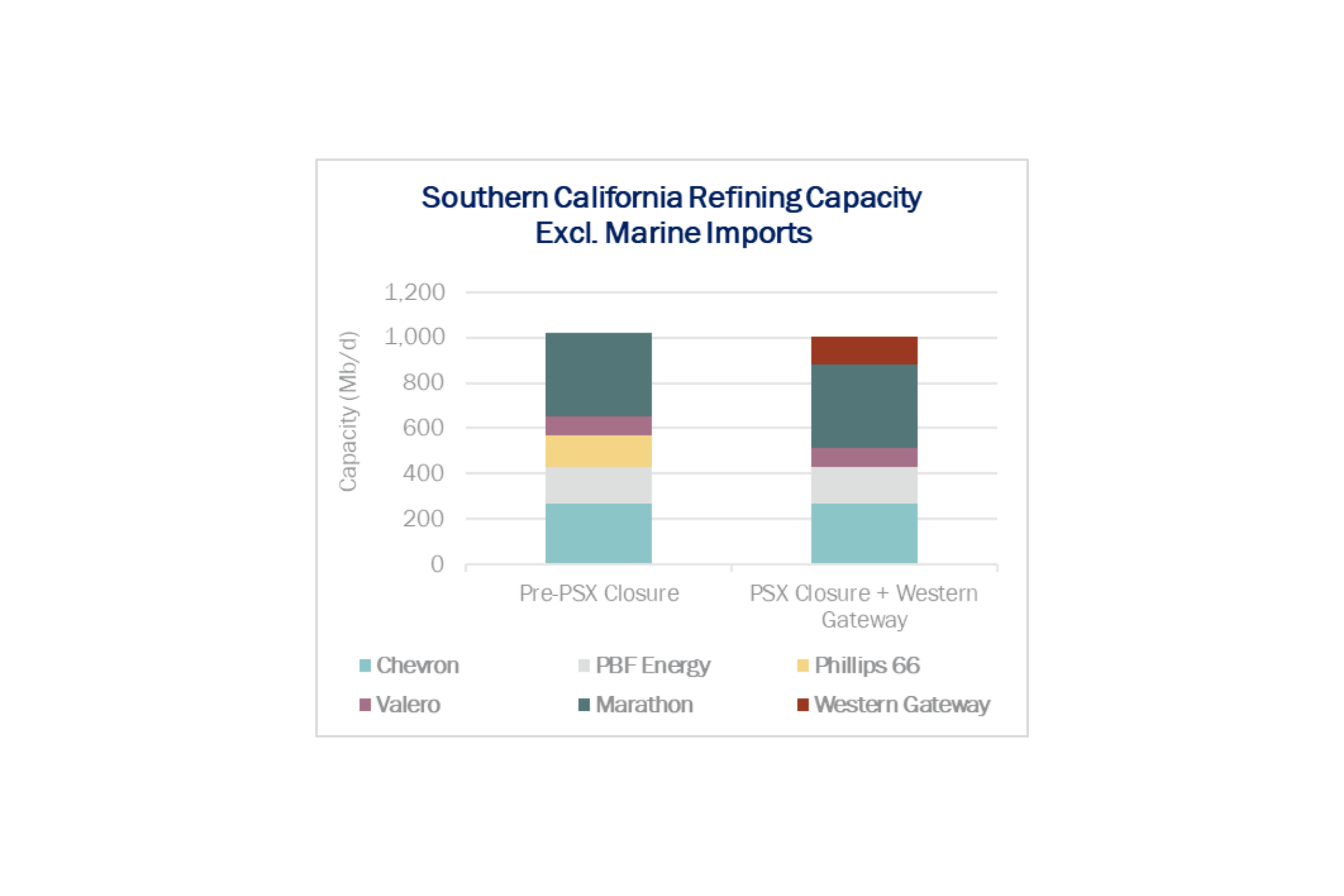Executive Summary:
Rigs: The total US rig count increased during the week of Oct. 26 to 515.
Infrastructure: Phillips 66 and Kinder Morgan plan the Western Gateway Pipeline to move 200 Mb/d of refined products from Texas to Arizona and California, challenging a proposal by ONEOK.
Supply & Demand: The US natural gas pipeline sample, a proxy for change in oil production, decreased 1% W-o-W across all liquids-focused basins.
Rigs:
The total US rig count increased during the week of Oct 26 to 515. Liquids-driven basins decreased 4 rigs W-o-W from 397 to 393.
- Anadarko (+3): Mewbourne Oil, US Oil Resources, Tamworth Resources
- Bakken (+1): Prima Exploration
- Permian:
- Delaware (-2): Chevron, Civitas Resources
- Midland (+1): Ovintiv

Infrastructure:
Phillips 66 (PSX) and Kinder Morgan (KMI) have launched an open season for the Western Gateway Pipeline, the latest salvo in an industry race to transport more refined products to California and the Southwest.
The companies propose to build a 20-inch pipeline from PSX’s Gold Pipeline in Borger, TX to Phoenix, AZ. Western Gateway would be fed volumes from Borger, as well as supplies connected to KMI’s SFPP refined products system in El Paso, TX. Western Gateway could move up to 200 Mb/d of refined products.

As part of the project, KMI would reverse the western leg of the SFPP system from Colton, CA to Phoenix, enabling east-to-west product flows into California, as well as to Las Vegas on KMI’s Calnev Pipeline (see project map).
The Gold Pipeline, which currently moves refined products from Borger to St. Louis, would also be reversed to move volumes westward. The Gold line connects to PSX refineries in Borger, TX; Ponca City, OK; and Wood River, IL with 700 Mb/d of combined capacity.
The open season, announced Oct. 20, will run through Dec. 19. Construction on Western Gateway could begin in 2027 if enough demand materializes, with completion expected in 2029. Phillips 66 will lead project construction, and KMI will operate the new pipeline.
The open season follows PSX’s recent $1.4B deal with Cenovus Energy (CVE) to acquire the remaining 50% stake in WRB Refining. The transaction gives Phillips 66 full ownership of the Wood River and Borger refineries.
Western Gateway would directly compete with the Sun Belt Connector proposed by ONEOK (OKE). The company in early September announced a project open season to move refined products from El Paso, TX to Phoenix, AZ, with estimated completion also in 2029. As a competitive advantage, KMI and PSX would leverage their Midwest and Southwest assets to transport refined products further into California, and to Las Vegas via KMI’s Calnev link.
The market opening arises as the West Coast has steadily lost refining capacity in recent years. Phillips 66 plans to close its Wilmington refinery (139 Mb/d capacity) by YE25, leaving just four major refiners in Southern California. Demand is also growing in Sun Belt states like Arizona from an influx of new residents. With Western Gateway, PSX would effectively offset the loss of the Wilmington refinery with refined products from its Midcontinent refineries (see figure).

Currently, California imports over half its crude oil from international sources. The value chain exposes the state’s consumers to premium international crude oil prices and higher transportation costs. Meanwhile, lost supply from the shuttered refiners is outstripping declining demand for refined products in California. With competition heating up in the Southwest to build refined products lines, PSX, KMI and OKE aim to seize the opportunity to fill the demand gap.

The Permian Basin at a Crossroads: Download Why This Pipeline Boom is Different
The Permian’s next big buildout is already taking shape — but this time, the drivers aren’t producers chasing oil. East Daley’s latest white paper reveals how gas demand from AI data centers, LNG exports, and utilities is rewriting the midstream playbook. Over 9 Bcf/d of new capacity and $12 billion in investments are reshaping flows, turning the Permian into a gas powerhouse even as rigs decline. Read Part II: Why This Pipeline Boom is Different
Supply and Demand
The US natural gas pipeline sample, a proxy for change in oil production, decreased 1% W-o-W across all liquids-focused basins.
The Arkoma sample decreased by 14.6% and the Rockies by 5.7% W-o-W. These decreases coincided with increases in the Barnett (+12.4%) and Anadarko (+ 3.8%). The Gulf of America sample declined 1.9%. The Rockies and the Gulf of America have a high correlation between gas volumes and crude oil volumes, whereas the Permian and Eagle Ford basins correlation is less than 45%.

As of Nov. 10, there is currently ~1,279 Mb/d of refining capacity offline for planned maintenance. Contributing to a large portion of the outages is the Pemex Deer Park refinery which accounts for 270 Mb/d.
Vessel traffic monitored by EDA along the Gulf Coast stayed flat W-o-W. There were 18 vessels loaded for the week ending Nov. 15, the lowest since the last week of August 2025.

Regulatory and Tariffs:
Presented by ARBO
Tariffs:
Gray Oak Pipeline, LLC: Certain available capacity discounts were increased.
Magellan Pipeline Company, L.P.: The tariffs were revised to add a new product and to update the product grade document to be consistent with ONEOK’s product grade documents.
The above information is provided by ARBO’s Oil Pipeline Tariff Monitor. For more information on regulatory proceedings or tariff rates, please contact please contact Corey Brill via email at [email protected] or phone at 202-505-5296. https://www.goarbo.com/


